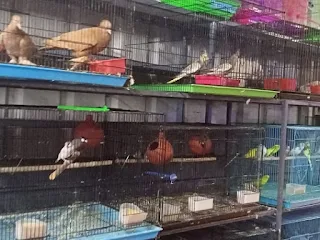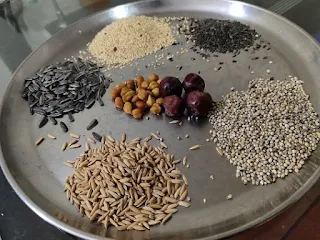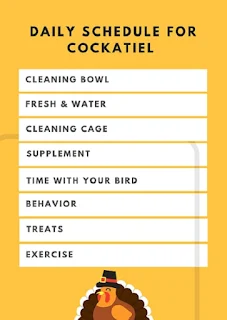About Cockatiel:
Cockatiels are birds from small parrot families from the regions of Australia. Cockatiels become famous for petting in the 1900 century, as cockatiels are calm, curious, feisty, chirp, and mimics. Cockatiel care involves providing these birds with a spacious cage, a healthy and balanced diet of pellets, fruits, vegetables, freshwater, and daily interaction and exercise outside their cage.
It's also important to provide them with toys and perches to keep them mentally stimulated and to clean their cage to maintain their hygiene regularly. Additionally, schedule regular check-ups with a veterinarian specializing in birds to ensure their overall health and well-being.
Many variations include Grey, Yellow, White-faced, Latino, and more. The average size of a Cockatiel is 27.94-35.56cm And a life span of 10-20 years. The longest Cockatiel lived was 30 years. Cockatiels are seed eaters, and like various fruits and veggies, Coriander leaves and Sunflower seeds are their favorites. Proper cockatiel care should include nutrients of protein and calcium for prevention from diseases.
Melanin and Psittacofulvins are pigments that decide the color of the Cockatiel. Melanin gives a grey color, whereas Psittacofulvins provides a yellow color. According to the content of dyes, different color combinations are formed. After mating, cockatiels lay their eggs after three weeks and incubate them for 20-25 days.
Difference Between Cockatiel And Conure: Which Is Better?
|
Cockatiel |
Conure |
|
They
are bigger than conure with 27.94-35.56cm |
They
are smaller than cockatiels with 22.86-30.48cm |
|
They
have a life span of 10-20 years |
They
have a life span of 10-15 years |
|
They
are less noisy compare to conure |
They
are noisy |
|
They
are Calm and relax |
They
are more active |
|
Less
beak power |
More
beak power |
|
More
interaction with everyone |
Interaction
only with family members |
|
Need
less attention compare to conure |
Need
more attention to compare to conure |
|
Less
horney compare to Conure |
More
horney |
|
Less
playful compare to Conure |
More
playful |
How To Get A Cockatiel For Beginners: Follow Steps
Step-1: Purchasing A Cockatiel
1. Visit a nearby pet shop to buy cockatiel.
• Check the eyes of the cockatiel, See eyes are black and not watering or red. The eyes of cockatiels should be clear and active.
6. Get a pair don't buy a cockatiel alone or your cockatiel will feel lonely.
|
Male |
Female |
|
Whistle more compare to female |
Whistle less compare to male |
|
Dark orange cheek |
Light orange cheek |
|
Vent area bones have less gap |
Vent area bones have more gap |
8. In India a cockatiel pair is about 3000-3500₹ it may vary in different states and regions of the world.
Step-2: Cage Setup
1. The cockatiel cage should have a dimension of length of 3ft, a height of 2.6ft, and a depth of 2ft, Length should be kept more than the height because cockatiels fly horizontally more than vertically.
Step-3:Essential Food And Medicine
1. Get 3 Clay bowls. In 1st bowl, you have to fill it with mixed seeds,2nd with soft food, and 3rd bowl for fresh water.
Step-4: Daily Schedule For Cockatiel
1. Wash food and water bowls with soap and water as cocktails poop in their water and food causing the digestive issue, So do washbowls before providing with food and water.
Conclusion
In conclusion, cockatiels make excellent pets for those who are willing to provide them with proper care and attention. Overall, with proper care and attention, cockatiels can make wonderful and entertaining companions for many years to come.
FAQ
1. What Is Bad For Cockatiels?
- Food like spinach, fruit seeds, avocado, salt, caffeine, honey, mushrooms, chocolate, uncooked beans, onions, garlic, and excess sugar is a toxic food for cockatiels.
- Harmful gases for cockatiels are chemical odors, pesticides, firecrackers, and matchsticks.
- Metals and Non-metals which are harmful are Teflon, lead zinc, copper, and aluminum.
2. How To Take Care Of A Cockatiel?
To care for a cockatiel, offer a large cage, a nutritious and balanced diet of pellets, fruits, and vegetables, clean water, and regular interaction and exercise outside the cage. Toys and perches should also be provided to keep them cognitively active, and their cage should be cleaned regularly to preserve hygiene.
Moreover, arrange frequent check-ups with a bird-specific veterinarian to guarantee their overall health and well-being.





